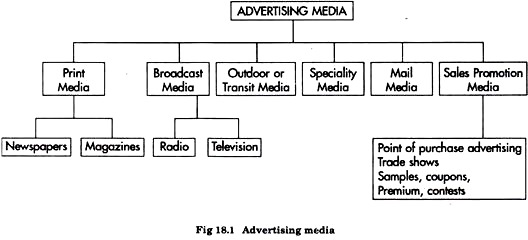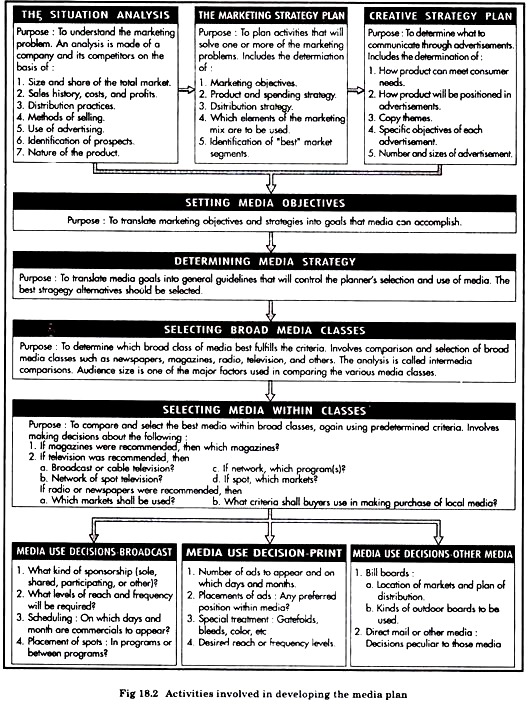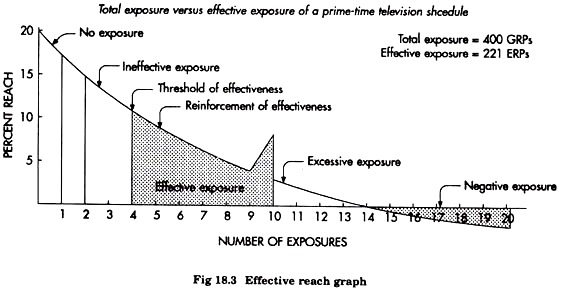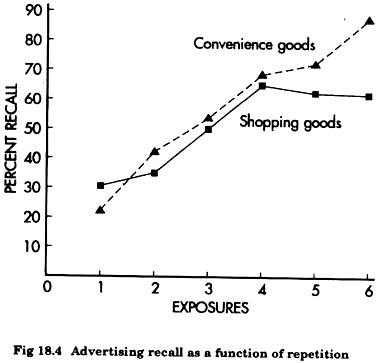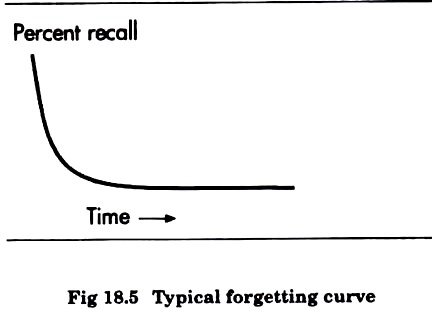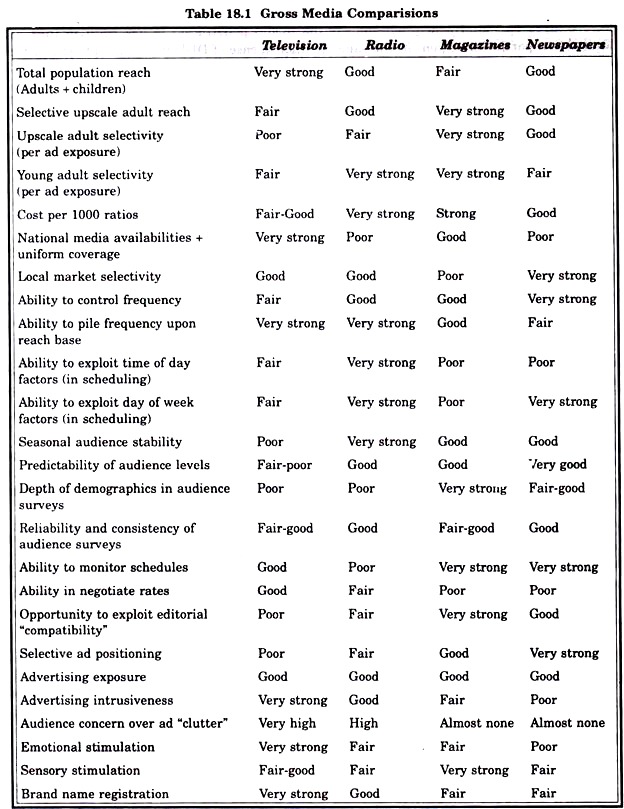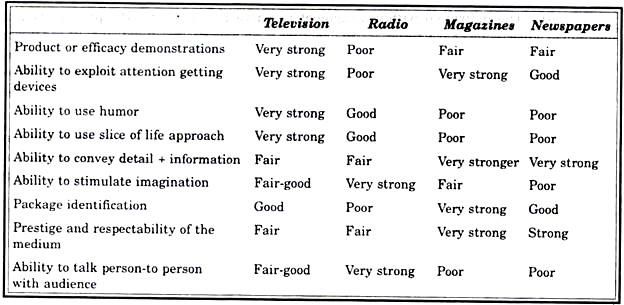After reading this article you will learn about the concept of advertising media planning for products.
An advertising medium is the vehicle used to carry the advertising message from the sender to the intended receiver. The introduction of new and evolution of existing media contribute to the already difficult task of media planning which involves when, where and how the message is to be delivered.
The primary objective of media planning is to develop a framework that will deliver the message to the target audience in the most efficient, cost effective manner possible. Media options include (Fig. 18.1) television, newspapers, radio and magazines as well as out of home media as outdoor advertising, transit advertising and electronic bill boards besides speciality advertising, point of purpose advertising.
While doing the media planning, the characteristics of each alternative must be considered along with many other factors. The product and or service being advertised affects the media planning process as it is found that some media are more useful than other in conveying their messages to specific target audiences.
Concept of Advertising Media Planning:
Media planning is the series of decisions involved in delivering promotional message to the prospective purchasers and/or users of the product or brand. Media planning is a process which means a number of decisions are made, each of which may be altered or abandoned as the plan develops.
The media plan is the guide for media selection. It requires media strategies i.e., plan of action which is designed to attain these objectives. The medium is the general category of available delivery systems which includes media classification (Fig. 18.2) the media vehicle is the specific carrier within a medium category.
There are basically there important concepts that are generally incorporated in the media planning process:
ADVERTISEMENTS:
(a) Reach
(b) Frequency
(c) Continuity.
(a) Reach:
Reach refers to the total number of households that will be exposed to the message through a particular media vehicle over a set period of time or it is measure of the number of different audience members exposed to at-least once to a media vehicle in a given period of time.
ADVERTISEMENTS:
Advertisers are mainly interested in the percentage of the total market that they can make reach their message through the media in a given area of coverage. Reach is usually expressed as a percentage of total number of households in a prescribed area that have been exposed to the advertising message.
The purpose of reach is the optimal exposure. The idea behind the strategy of greater reach is that the advertisement be received by as many people as possible at the first instance. Achieving awareness requires reach i.e. exposing buyers to the message.
New brands or products need a very high level of reach since the objective is to make all potential buyers aware of the new entry. High reach is also desired at later stages of the product life cycle.
The strategy of greater reach is desirable in following circumstances:
ADVERTISEMENTS:
1. When introducing the new use for the product in order to expand its market share.
2. To improve the image of the company.
3. When the new product is introduced.
The problem arises when there is no known way of determining how much x each is required to achieve the levels of awareness, attitude change or buying intentions nor can we be sure an advertisement placed in a vehicle will actually reach the intended audience.
ADVERTISEMENTS:
Determining Effective Reach:
Since marketers have budget constraints, they must decide whether to increase reach at the expense of frequency or increase the frequency of exposures but to a smaller audience. A number of factors will influence this decision. For example, a new product or brand introduction would attempt to maximize reach to create awareness as many people as possible as quickly as possible.
At the same time, for a high involvement product or one whose benefits are not obvious, a certain level of frequency is necessary to achieve effective reach. Effective reach represents the percentage of a vehicle’s audience reached at each effective frequency increment. This concept is based on the assumption that one exposure to an advertisement may not be sufficient to convey the desired message.
As no one knows the exact number of exposures necessary for an advertisement to make an impact, although the advertisers have settled on 3 as minimum. Referring to Fig. 18.3 effective reach (exposure) is shown by shaded area with a range of 3-10 exposures.
Below 3 exposures reach is considered insufficient while beyond 10 is considered excessive exposure and thus ineffective reach. This exposure level is no guarantee of effective communication as different messages may require more or fewer exposures.
(b) Frequency:
Frequency refers to the number of times the receiver is exposed to the media vehicle in a specified vehicle, or refers to the number of exposures to the same message that each household supposedly receives. Since the frequency may differ for different set of households the average frequency is
Average frequency = Total exposure for all households/Reach
ADVERTISEMENTS:
Average frequency means that the average household is exposed to the message … times.
Frequency primarily means repetition of the same message and the objective of greater frequency is to promote interest and desire for the product on a continuous basis.
It is advisable to go for high frequency under the following situations:
1. When the message is not easy to remember.
2. When the direct order from people is desired as a result of a given advertisement.
ADVERTISEMENTS:
3. When competitor is using high frequency to reach the same segment of the market.
4. If the product or brand is not sufficiently differentiated from products and brands of competitors.
5. When a reaction is desired within a limited time period.
Factors Important in Determining Frequency Levels:
These factors can be broadly classified as:
(i) Media factors
ADVERTISEMENTS:
(ii) Marketing factors
(iii) Message or creative factors.
(i) Media Factors: It includes:
(a) Attentiveness:
The higher the level of attention achieved by the media vehicle, the less frequency is required. Low attention getting media will require more repetitions.
(b) Number of Media used:
ADVERTISEMENTS:
The fewer media are used, the lower, the level of frequency required.
(c) Clutter:
The more advertising that appear^ in the media used, the more frequency is needed to break through the clutter.
(d) Repeat Exposure:
Media that allow for more repeat exposures—for example, monthly magazines require less frequency.
(e) Editorial Environment:
ADVERTISEMENTS:
An ad that is consistent with the editorial environment needs lower levels of frequency.
(f) Scheduling:
Continuous scheduling requires less frequency than does flighting or pulsing.
(ii) Marketing Factors: It includes:
(a) Brand Loyalty:
An inverse relationship exists between loyalty and frequency. The higher the loyalty, the lower the frequency level required.
ADVERTISEMENTS:
(b) Usage Cycle:
Products used daily will quickly needed to be replaced. A higher level of frequency is desired.
(c) Brand History:
Is the brand new or established? New brands generally require higher frequency levels.
(d) Target Group:
The ability of the target group to learn and to retain messages has a direct effect on frequency.
(e) Brand Share:
An inverse relationship exists between share and frequency. The higher the brand share, the lower the frequency level required.
(f) Competitive Share of Voice:
Higher frequency levels are required when a lot of competitive noise exists and when the goal is to meet or beat competitors.
(g) Purchase Cycles:
Shorter purchasing cycles require higher frequency levels to maintain top of mind awareness.
(iii) Message or Creative Factors: It includes:
(a) Image Versus Product Sell:
Creating an image requires higher levels of frequency than does a specific product sell.
(b) Message Complexity:
The simpler the message, the less frequency required.
(c) Advertising Units:
Larger units of advertising require less frequency than smaller ones to get the message across.
(d) Message Uniqueness:
The more unique the message, the lower the frequency level required.
(f) Wear Out:
Higher frequency may lead to wear-out. This effect must be tracked and used to evaluate frequency levels.
(g) New Versus Continuing Campaigns:
New campaigns require higher levels of frequency to register the message.
(h) Message Variation:
A single message requires less frequency. A variety of messages requires more.
Effects of Reach & Frequency:
1. Beyond three exposures within a brand purchase cycle or over a period of four or even eight – weeks, increasing frequency continues to build advertising effectiveness at a decreasing rate but with no evidence of decline.
2. Although there are general principles with respect to frequency of exposure and its relationship to advertising effectiveness, differential effects by brand are equally important.
3. Since one exposure is usually in effective, the central goal of productive media planning should be to enhance frequency rather than reach.
4. One exposure of an ad to a target group within a purchase cycle has little or no effect in most circumstances.
5. The data strongly suggest that wear out is not a function of too much frequency; it is more of a creative or copy problem.
6. The evidence suggests strongly that an exposure frequency of two within a purchase cycle is an effective level.
7. Nothing we have seen suggests that frequency response principles or generalisations vary by medium.
(c) Continuity:
As the impact of an advertisement reduces after a certain period of time so it is important that the advertisement is to be repeated after a certain period of time to make an impact.
When a consumer continue to view or hear about the product or the company in a positive way, it helps him to remember the product continuity has a cumulative effect of advertising on the consumer and is dependent upon the length of the time the advertisement runs.
Gross Rating Points (GRP):
The media buyer typically uses a numerical indicator (GRP) to know how many potential audience members might be exposed to a series of commercials.
GRP = Reach x Frequency.
GRP is the total audience that might be reached by a media schedule.
Flexibility in Media Planning:
An effective media strategy requires a degree of flexibility. Because of the dynamism of the environment, strategies may need to be modified.
Flexibility in media planning is required because of the following reasons:
(a) Market threats
(b) Non availability of media
(c) Changes in media or media vehicles
(d) Market opportunities.
(a) Market Threats:
Internal or external factors may pose a threat to the firm, and a change in media strategy is dictated. For example, a competitor may alter its media strategy to gain an edge. Failure to respond to this challenge could create problems for the firm.
(b) Non Availability of Media:
Sometimes a desired medium (or vehicle) is not available to the marketer. Perhaps the medium does not reach a particular target segment or has no time or space available. There are still some areas of this country where certain media do not reach.
Even when the media are available, limited advertising time or space may have already been sold or cut off date for entry may have passed. Alternative vehicles or media must then be considered.
(c) Changes in Media or Media Vehicles:
A change in the medium or in a particular vehicle may necessitate a change in the media strategy. For example, the advent of cable TV opened up new opportunities for message delivery, as will the introduction of interactive media.
(d) Market Opportunities:
Sometimes a market opportunity arises that the advertiser wishes to take advantage of. For example, the development of a new advertising medium may offer an opportunity that was not previously available.
Media Selection Considerations:
High media selection is very important to achieve optimal results.
The selection of media would depend on many factors and the media selectors should consider the following factors to decide the optimum media mix:
1. Cost
2. Competitor’s advertising media
3. Customers and target market
4. The product
5. Media penetration & coverage
6. Advertising objectives.
1. Cost:
It is most important factor to consider because every advertiser has a limited budget and in that limited budget he has to achieve the optimum results. Advertiser has to select that media mix which will lead to achieve advertising objectives with the balance of its advertising budget.
2. Competitor’s Advertising Media:
The media selected by the competitors have a strong influence on our advertising media selection. Though there is no matching between the competitor’s media and advertising and ours because every advertiser promote its product in its own way. Nonetheless, it is advisable to assess the competitor’s strategy and the choice of media.
3. Customers and Target Market:
For getting the optimum result from advertising it is important that the message should reach as many potential buyers as possible. Reaching people who are not potential customers is a waste of money.
If the product belongs to a particular class of customers e.g., women, men or children then the media selected should be such which is reached to maximum number of persons of that group. The advertiser has also to see the geographic distribution of the product. If the product is distributed locally then there is no use of choosing national medium.
4. The Product:
Type and utility would decide the medium on which the product is to be advertised. For example, if the product requires demonstration of utility than a TV commercial would be more suitable. Advertisements of industrial products as well as consumer products which provide too much information and are descriptive, projective are more suited to the print media.
5. Media Penetration and Coverage:
Medium penetration and coverage also play an important role in media selection. For example, on DDI the programmes which are telecasted, some belong to national network whose penetration is all over India while the programme by local centres like afternoon programmes—the media penetration is low because they are limited to a particular region.
In the same manner in case of DDII it is limited to the metros only and the media penetration and coverage is low as compared to DDI.
6. Advertising Objectives:
At different points of times and in the different stages of the product life cycle the advertising objectives are different. A company that wants of build up its image may want to advertise in prestigious magazines which are read by people who think objectively. With the persuation objective, the selection of media would be different e.g., broadcast as well as print with different types of advertisements.
Media Weight Theories:
A Media schedule may contain only one medium or a relatively large number of media.
Media weight theories concern the number of media selected and the emphasis is placed on each of these in the schedule:
(a) The media concentration theory
(b) The wave theory
(c) The media dominance theory.
(a) The Media Concentration Theory:
Media concentration offers media dominance and continuity within one medium only. It suggests that the advertiser develops strength by concentrating in one medium rather than expending funds over a variety of media.
(b) The Wave Theory:
The advertiser purchases time and space in various media for a relatively short time and moves in and out of these media in “waves”. The advertiser hopes that the impact of the advertising will carry over from the periods of heavy concentration to those of no advertising. The wave theory scarifies continuity and builds up coverage and/or frequency
(c) The Media Dominance Theory:
The theory of media dominance suggests that the advertiser buy an unusually large amount of space in one medium for a short period of time. After building up coverage and frequency in that medium, the advertiser shifts expenditures to another medium, again for a short period of time.
Thus, although exposure time is limited, the advertiser benefits from dominance in one particular medium, as well as a maintenance of continuity over a variety of media.
Use of Computers and Models for Media Strategy:
The use of computers and models in determining media strategy is increasing as a result of the increased size and complexities of media schedules. The computer has been used since the late fifties. Market segmentation, product positioning, media agency etc., are easily decided by computers.
The media models are linear programming models, heuristic models, simulation models. The prospective customers, along with the alternative media schedules, are placed in the computer and each schedule is evaluated in terms of its reach to the potential customers.
(a) Heuristic Models:
The heuristic models are based on the rule of the thumb. The solution may not necessarily be optimal but it should be good solution. Each succeeding solution is better than the previous solution. A high assay media model based on the heuristic principle was developed by the Young and Rubicam agency. It was based on the sequential approach to media selection.
Potential market cost and the schedule time of the media are evaluated to select the media. Many other agencies developed models on the basis of the heuristic approach. These models have been useful, flexible, and accumulative.
(b) Linear Programming Models:
The linear programming models develop an optimal solution among all the variables that have linear relationships. They tell advertisers how to allocate scarce resources among many alternatives in order to maximise the results.
One of the important models of linear programming was developed by the Batter, Barton, Durstine and Osborn advertising agency. They assumed that the audience response is a function of exposure.
The response rate depends on the exposure rate. They have not assumed the reality that the response rate increases in beginning, remains constant for sometime and declines thereafter, although the exposure rate may remain constant or may increase during the period.
The cost per thousand (CPM) was not regarded under linear programming models, which do not record non-linear exposure. Vehicle selection, media and objectives are directed and managed, not for optimal but for practical achievements.
(c) Simulation Models:
The simulation models are designed to evaluated alternative media schedules and strategies. The two simulation models are MEDIAC and ADMOD.
Mediac Model:
The MEDIAC model was developed by John D.C. little and Leonard M. Lodish. It is useful in the sense that it maximises the sales in market segments rather than achieving optimum exposure.
It considers individual market segments, the market potential with in the segments, the rate of forgetting, the exposure efficiency of various media vehicles and media vehicle costs. The individual within a segment is exposed to message.
The probability is a function of advertising characteristics. An exposure to an advertisement will change consumer predisposition to buy the advertised product. The rate of change is function of media and message.
The model is provided with an estimate of sales response to different levels of exposure. It is converted into exposure level to sales response for each segment. This model develops an optimal insertion level and the schedule of each insertion.
Advertising exposures build up the exposure value that affects sales. The relationship may not be necessarily linear. The exposure value, as time passes, is gradually forgotten. The advertiser should, therefore, lay stress, on the reminding objectives.
This model may be presented as follows:
d s j t = h j g s j R j t
where,
d s j t = expected number of exposures per person obtained in segments from media option j at time period t.
hj = probability of exposure media option j, given that a person is in the audience of vehicle j.
g s t= fraction of people in market segments who are in the audience of vehicle j as the average.
K jt = seasonal index of audience size for vehicle j
Thus, the expected number of exposures of advertising depends upon media option, market segment and seasonal index.
Admod Model:
The ADMOD model aims to achieve cognitive changes in consumption patterns among the selected potential customers. These changes are known as cognitions about a product change, which takes place over a period of time. The current expenditure will return a future stream of income or profit.
The present value of future income is maximised by the ADMOD model. The present value of future income is tallied with the present expenditure to find out the actual return as the expenditure on advertisements.
This model concentrates within the segment rather than the total segment. Individuals are randomly selected within a segment to determine the impact of the particular medium on each individual within the segment.
The impact is the cognitive change among the sample individuals’. Similarly, the cognitive changes of each medium are evaluated and their rate in the change process is ranked to frame the media schedule.
The exposure probabilities of the media option can be measured in the following way:
Pi j = bi j hj
Pi j = probability that individual i is expected to be exposed to media options j.
bi J = probability that individual i is exposed to vehicle j where vehicle j is the vehicle associated with media option j.
hj = probability that anyone exposed to vehicle j will be exposed to media option j.
The ADMOD model assumes that an advertising campaign of a specified duration attempts to change cognition or precipitate decisions. Advertising is likely to generate the desired change in cognition or decision in a rather limited time period. Those individuals who with stand a concentrated effort for a relatively short time will probably with stand the same campaign if it is prolonged.
Media strategy is an important aspect of the total advertising campaign. Media characteristics are matched with market characteristics to enhance the possibility of favourable consumer attitude to the market and the product. The length of the campaign determines the rate of exposure. Advertisers, therefore, should consider all these factors to determine and implement an appropriate media strategy.
Media Selection Summary:
In the selection of media, the following questions are among the more important ones the advertiser should consider:
1. Does the medium reach the right audience?
2. Is the environment of the medium is one that will produce interest and confidence in the products advertised?
3. What will be the cost of reaching prospects in the different media?
4. What type of exposure can the advertiser hope to secure in the media?
5. What is the image of the medium in the minds of the prospects?
6. What is the purchasing behaviour of the media audience?
7. What merchandising services are provided by the media?
8. What is the accumulation of audience numbers by successive programmes or issues of the printed publication?
9. How is the distribution of the product correlated to the circulation of the media?
10. How many people does it reach?
11. How much duplication is there among the different media?
12. Will the budget of the advertiser justify the use of the media?
13. What data are available to judge the media?
Since media charges generally represent the largest expenditure in the advertising budget and the success of a campaign depends upon sound media choices, advertisers increasingly are concerned with objective methods of evaluating media in their selection.
